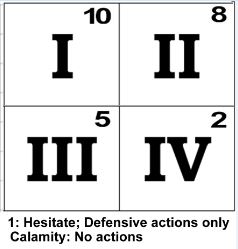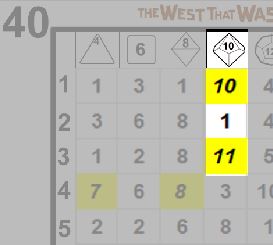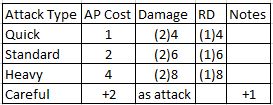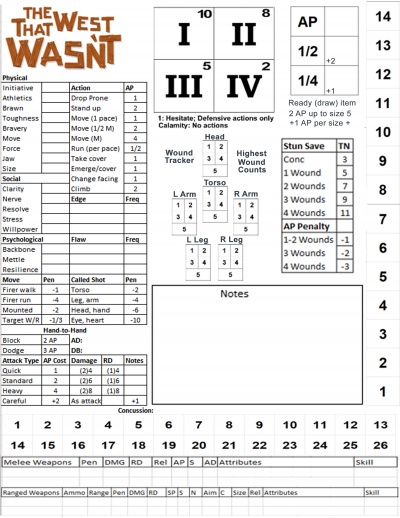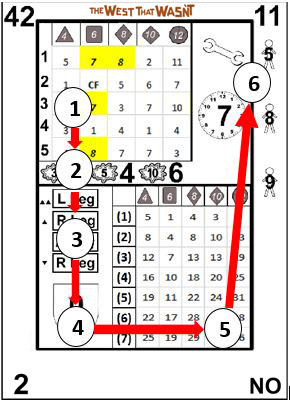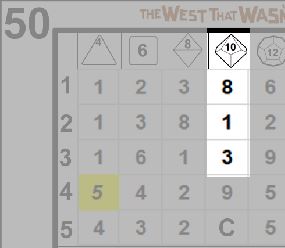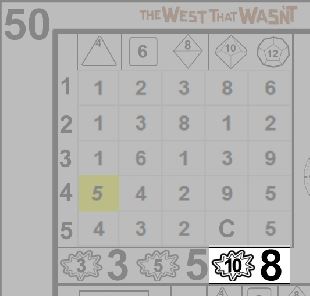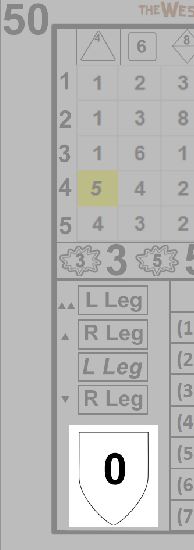Difference between revisions of "The West That Wasnt - Conflict - Action Points"
m (→Resolution Flow) |
m (→Armor Penetration/Ablation) |
||
| Line 402: | Line 402: | ||
Attacks that penetrate do full damage. Attacks that ablate do reduced damage. In both cases, the protection value is decremented. Attacks that deflect do no damage and the protection value is unaffected. | Attacks that penetrate do full damage. Attacks that ablate do reduced damage. In both cases, the protection value is decremented. Attacks that deflect do no damage and the protection value is unaffected. | ||
| − | Characters have no | + | Characters have no natural armor versus weapons that do deadly damage. These weapons automatically penetrate for full damage, unless the character has cover or some other means of protection. |
===Tech Level and Armor Penetration/Ablation=== | ===Tech Level and Armor Penetration/Ablation=== | ||
Revision as of 15:17, 6 April 2020
You have a Hero, and you know what the numbers mean and how the cards function. Now it is time to begin bringing the narrative to life. A good story is never easy. The protagonist finds obstacles at every turn. Overcoming these obstacles forms the basis of both the Hero and the story. Whenever a Hero is at odds with some element of the universe, there is conflict. When that conflict escalates into the physical, the Judge breaks the game down into "rounds". This may also be referred to as "action time".
Contents
- 1 Action Time
- 2 Movement
- 3 Combat Actions
- 4 Applying Damage and Wound Effects
- 5 Action Cards in Combat
Action Time
When the Judge declares action time, the sequence of game play becomes more structured. Each round is divided into four phases (I-IV). Within each phase ties are broken by Reflex die type, equipment, and other factors. After each phase is a continuous action phase (if necessary).
Initiative and Declaration
During each round of combat, the first thing that must be determined is the order of actions. Each player must determine how many APs they will use that round, and then determine when their action will resolve. Rounds are divided into four phases (I-IV), actions within each phase are considered to be virtually simultaneous.
On the character sheet is a track with the numbers 1-14. This is for initiative declaration purposes and AP tracking. Each player places their initiative token on a number within the track that will be the number of APs they will use that round. This number cannot exceed the total APs the character has available. A player that does not allocate before drawing their card is assumed to be using all available APs.
The AP tracker also lists values for 1/2 and 1/4 of the AP value, which will be explained below.
Choosing Less
Why would any player choose to spend less than their total APs? There are two reasons fewer APs may be chosen during a round. The first is that characters who use half or less of their APs receive a bonus of +1 in the Phase determination, and those who use one quarter or less receive a +2. Doing less increases the chance of going first.
The second reason is in-Phase timing. While the actions within the same Phase are considered to be virtually simultaneous, there is an order of operations, and the first tie breaker is surplus APs. The character with the most surplus APs goes first in the Phase. The second tie breaker is equipment attributes. The final tie breaker is Reflex die type. Characters who remain tied act simultaneously.
Resolving Initiative
Once the available APs for the round have been chosen, the player resolves a simple Reflex check to determine in which Phase they act. The TNs for each Phase are:
Phase I: 10
Phase II: 8
Phase III: 5
Phase IV: 2
The TN to act in the given Phase is located in the upper right corner.
Characters who generate a 1 or less hesitate and do not act that round. They still have their full defense, and may use APs for defensive maneuvers. Characters who generate a Calamity hesitate and have no APs to spend on defensive actions.
After determining the Phase, the player should place their initiative token in the appropriate box on their character sheet. This may be kept hidden until the Phase occurs, if the player wishes.
Movement
At the end of the initiative resolution characters are arranged in order from fastest to slowest. Resolving the turn is a two step process: movement and action resolution. Movement begins with the last character and proceeds in reverse order to the first.
Why does the last character go first?
By having the last character move first, we reward the quicker reactions of those at the beginning of the initiative spectrum. They are able to see and react to the movements of those who are slower. More on this later.
Resolving Movement
A character resolves their movement by spending the appropriate APs and moving their figure on the tactical map. When the player no longer wishes to pay APs, the movement ends. Scale movement is in inches or hexes on the battle map, or paces in the world of the west. One pace is approximately equal to one meter or yard.
Movement AP Cost
The following are AP costs for movement. Characters may change facing up to 60 degrees (one hexside) per pace of movement for free.
Drop prone: 1 AP
Stand up: 2 AP
Maneuver: 1 AP move one pace
Maneuver: 2 AP move up to half Rate
Maneuver: 4 AP move up to Rate
Run: 1/2 AP per pace
Duck behind cover: 1 AP
Emerge from cover: 1 AP
Change facing 60 degrees without moving: 1 AP
Change facing more than 60 degrees without moving: 2 AP
Change facing 120 degrees during a move: 1 AP
Mounts have special movement costs that depend on the quality and type, as do vehicles.
Interrupting Movement
At any time during the movement any other character may declare their intention to interrupt the movement of the character that is currently moving. They indicate this by placing their target token on the spot in the movement where they intend to target the character. If the intended action is a ranged attack, the character finishes their movement and action moves to the next character.
If, however, the faster character wishes to engage the character in melee combat, the moving character stops immediately. When the interrupter has their turn in the order they move adjacent to the token they placed.
Combat Actions
Now that we know when characters will go, what exactly will they do? What follows is a description of how to moderate the turn. Actions are resolved in order starting at the top of the initiative stack. Each action is fully resolved before moving on to the next one. Results and consequences of actions are applied immediately.
Combat actions begin with the first character in Phase I. Each action is fully resolved before moving on to the next one, and all APs are paid before resolving the action. Characters may save APs for defensive actions later in the turn.
EXAMPLE
Multiple Attacks
Whether in ranged or hand to hand combat, characters have enough APs to make multiple attacks in a single round if desired. Unless expressly provided otherwise (such as with certain advanced skills) characters only receive a single attack dice pool no matter how many attacks are made. This means only one card can be used to resolve all cause actions (hits and misses). All characters are limited to a number of attacks equal to their rank in the appropriate skill, or their trait skill if attacking unskilled.
Resolving Multiple Attacks
All attacks and their targets must be declared before drawing the card. The order of attacks must also be clear. To resolve the attacks, draw a card and use the highest result in the pool for the first attack, the second highest for the second, etc. Continue until all attacks have been fully resolved.
Resolving the effect is slightly more complicated. The first attack uses the initial card that is drawn. Any further attacks that score hits require a second draw, but only the effect area of the card is used. If any cause results generate exceptional results, the card(s) used for the exceptional result is not used for anything else, discard them immediately after resolving the result.
Ranged Combat
A ranged attack is a Dexterity (sometimes Acuity) check with modifiers based on the situation. Some common modifiers are range, target size, movement and other distractions. Those potential modifiers are discussed below.
Range
The Target Number required is Standard (5) plus any relevant modifiers. Add one to the TN for each full range increment between the firer and target. See the gear section for any applicable range increments or other vital details regarding weaponry.
Cyril Wellington wishes to plug an unsuspecting villain in the back with a shot from his .44 Schofield. The range increment for this weapon is 10. The TN to hit the villain up to 10 paces away is 5, up to 20 it is 6, etc.
Point Blank
Point-blank range is used when one character is holding a weapon in contact with another character, using them like a shield, holding them hostage, or shooting over a table where they both sit. In general, the weapon should be close enough to touch the target with arms extended.
Modifiers
The previous paragraphs describe what is known as the base TN, other modifiers may also be relevant to your check. A firefight is a chaotic and unpredictable environment. The Judge will inform you of any modifiers which are appropriate. Some common modifiers are listed below.
| Situation | Modifier | |
| Firer is moving | -1/-4 (walk/run) | |
| Firer is mounted | -2 | |
| Firer is wounded | Varies (See Stun section, below) | |
| Size | Varies | |
| Target is moving | -1 per 5 meters relative speed |
Move and Fire
If the character is moving, the TN is adjusted by either -1 or -4, depending on the speed.
Mounted characters are a special case. The modifier listed is used only if it is worse than the movement penalty applied from firer movement. So a stationary or walking mount confers a -2 penalty on shooting, while a galloping mount costs the character a penalty of 4.
Target Size
If the target has a size 3 or less (1/2 human size), add 1 to the TN. If it's two or less, add 2, and so on, to a maximum of -6 (increments at .5, .25 etc). The opposite is also true. A target that is size 12 gives the character a +1 bonus to the result, a target size 18 has a +2 modifier, and so on, up to a maximum of +6.
Target Speed
Of course, it's harder to hit a moving target than one that's standing still. A penalty of one is applied for each 5 meters of relative speed between the firer and target. "Relative" means you need to take into account how fast the target and the shooter are moving in relation to each other.
Miranda is chasing a bandit down Main. She has a Speed of 12, he has a speed of 8. The relative speed is 4, meaning the penalty is 0. If both were running (double speed), the relative speed would be 8, for a penalty of 1.
Hank is driving his wagon east down Legless Gulch, with Cyril in the back riding shotgun. Cyril spies an ornery vaquero heading west down the mountain trail, leading into the gulch. He knows when the hombre gets into the gulch, he will hightail it and be right behind them in a jiffy, so he wants to take a shot with his shotgun as soon as possible. Reuben is pushing his nags to 18 paces Speed, while the vaquero is going only 8 paces Speed down the rocky trail. Since they are going opposite directions, the relative speed is 26, for a -5.
Not all groups prefer the idea of relative movement. If you prefer to use total movement instead of relative movement, check with the Judge and be consistent. Play the game you want to play!
Throwing Things
The throwing skill works just like shooting for most weapons. The Range Increment for all thrown weapons is +1/(Strength value + 2), so a 2d8 Strength would add +1 to the base TN of Standard (5) for every 6 paces distance. A target at 10 meters is TN 7 (8/2 =4, +2 is 6). The maximum range a character can throw an average size weapon (1-2 pounds) is Strength trait value x 5 meters.
Aim and Snap Shots
Each ranged weapon has an aim value, expressed as a number followed by a slash and a negative number (ex: 2/-1). The first number is the AP cost of an aim action for that weapon, and the negative number is the penalty the weapon takes if used without a preceding aim action. A shot that is preceded by a single aim action does not take the penalty, but does not receive any aimed shot bonus (this is a standard shot). All further aim actions add +1 to the result, and are considered aimed.
Some weapons have an attribute called Accurate, which is followed by a number in parentheses. If aimed, that number is added to the result before comparing to the TN. A weapon may be aimed up to two consecutive actions for added bonus.
Cyril Wellington is hidden across the street behind a vaquero who is holding Miranda at bay. He knows he only has one shot in his Schofield, so he needs to make it count. He decides to spend 2 AP to remove the snap shot penalty, then 4 more AP to aim twice, granting himself a total bonus of +2 on his shot. The shot itself will cost an extra 1 AP, for a grand total of 7.
Aim does not persist from shot to shot. Any firing action also nullifies the aim. Anytime a weapon is fired without a preceding aim action at the target it is considered a snap shot.
When making an aimed shot, the character may choose to use either their Dexterity or Acuity trait. This could vary from shot to shot, if the situation warranted.
Tactical Aiming
Aiming on a range or in a pasture is simple; aiming while .45 caliber slugs whiz past your ears is another thing entirely. In TWTW, aiming is an action that may take all or part of a character turn. To aim during combat, use the following procedures.
1. Determine if the character may lose aim. A character may lose aim if: Another character attacked them since their aim began, or since their last action.
2. If the character may lose aim due to being the target of a ranged attack, pay the AP for the aim and then perform a Standard (5) Bravery check. Add 1 to the TN for each shot after the first that targets the character, and 2 to the TN for each attack that hit the character. If the check succeeds, previous aim is preserved and the character may aim as normal. If the check fails, the AP are spent, but all previous aim is lost and the aim does not resolve. Aiming may not be attempted again this round.
3. If the character may lose aim due to a melee attack, perform a Difficult (9) Bravery check. Failure indicates loss of aim, as above. If the character was hit by a melee attack of any kind, they may not aim, and any aim they had accumulated was lost.
4. If none of the preceding apply, the character may aim as normal.
In all cases, perform the Bravery check immediately before drawing the card to resolve the action. The player is not allowed to change actions or targets after determining aim status. Resolve the Bravery check and attack separately, on different cards.
Aim and Cover
Characters behind cover receive a bonus to performing and maintaining aim. Whenever a character wishes to perform an aim action, add the armor value of the cover to their Bravery result. The character must have been behind cover for their entire turn. If a character moved between two instances of cover during their turn, add the lowest armor value to the result.
Fan Firing
Single action revolvers are capable of an attack called fan firing. When fan firing, the trigger is held down, while the off hand slams, or "fans", the hammer repeatedly, cocking the weapon as it fires. It can be wildly inaccurate, and should only be attempted by skilled (or crazy) practitioners.
When using fan fire, first declare the number of shots to be attempted, and also the targets. For each shot the TN is increased by 1 successively, starting with the first. Each target after the first increases the difficulty an additional 1, successively. Fan-firing is never aimed, even if an aim action was performed before the first shot.
When fan-firing, each shot is resolved separately, but from the same card, so the order and target must be clear before drawing the card. No changes can be made to the series once the card is drawn.
Miranda wants to spend her last four rounds on Angus and his two most trusted cronies, cowering near the back door of the hacienda. She declares the first two shots to be on Angus, then one apiece on the other two. Her weapon of choice is a Colt Peacemaker 45, short barrel. The first shot on Angus is -3 (-2 for lack of aim, -1 for fan fire), the second shot is -4 (extra -2 for fan fire). The shot on crony 1 is -6 (an additional -1 for fan fire and -1 for second target) and the last crony is fortunate that her penalty is -8 (-1 for a third target and -1 more for fan fire)...near impossible.
If any shot scores bumps, those bumps cannot be used on other shots. Each shot is a separate resolution.
Cyril fancies himself a card sharp, and usually he comes home a few dollars richer, while also buying himself a drink or two. This evening, however, he finds himself on the wrong end of two jilted Perkins brothers holding Bowie knives. He has drawn his Schofield, but given their close range (3 paces) and shared hatred of him, he knows his only chance is to take them both out at once. He decides to attempt a fan fire, where his pistol skill is 3 and his Dexterity d10. He draws a card...
The standard TN is 5, but he is attempting to fan fire 2 shots, making the new total 8 and 9 (due to lack of aim), plus one additional on the second brother for a total of 10. His results on the card are 10, 1, 11. Success! Incredibly, both brothers are hit.
When fan-firing, any successive shots resolve hit locations on separate cards (the shots are not grouped).
Pushing the Limit
Revolvers are not designed for fan-firing. Increase the Rel of any revolver by 1 when fan-firing.
Two Weapons
A Hero using weapons in each hand suffers -1 to each attack. Any action taken with an off hand is made at an additional -3 (for a total of -4). A hero can fire with each hand up to the weapons’ usual rate of fire. Resolve each hand as a separate check.
The previous penalties are in addition to any snap shot penalties for the weapon. Aiming two weapons is only possible if they are pointed together (held closely, so the eyes can see both sights simultaneously), at a single target. This kind of aim takes concentration, so increase the AP cost of any aim action by 2. It is never possible to aim at two different targets, at least one of the shots must be attempted as a snap shot.
Two handed ranged weapons
Generally speaking, you need two hands to operate a rifle, but it can be done with one. Apply a penalty of 2 to any two-handed ranged weapon being used with one hand. For larger weapons, be sure to consult the weight of the weapon and the Strength of the user.
Hand to Hand Combat
When two combatants are within one pace of one another, either may choose to initiate hand to hand combat. Hand to hand combat may be armed or unarmed, and the skills required vary with the weapon and attack types chosen. There are four attacks available:
Any attack can be a careful attack, the cost is increased by 2 AP and +1 is added to the result. The cost and bonus for careful can only be applied once per attack. Both armed and unarmed attacks use the same four standard attack types. Attacks do the damage listed plus the Damage Bonus (DB) of the character making the attack.
There are also two defensive maneuvers that may be employed: block and dodge. Block works against a single incoming attack and costs 2 AP. Multiple blocks may be performed in a turn. Dodge works versus all attacks coming from a given direction, usually 120 degrees (two hexsides, or Judge discretion) and costs 3 AP.
To utilize block, declare your intention before the attacker draws a card. Once the result is known, make an unarmed combat test against a TN equal to the result of the incoming attack. If the block result is equal to the attack TN, change the hit location to the off arm (or whatever arm is making the block). If the block result is greater, the attack is successfully blocked and has no effect.
Blocking may also be performed with a weapon. In this case, the procedure is as above except substitute the appropriate weapon skill. Also, do not forget to check for equipment breakage during the block attempt.
To perform a dodge, state your intent before the attacker draws a card. The TN to hit the dodging character is 3 plus the AD value of the character.
Determining Results
Once opponents have been chosen and a character is ready to perform an attack, the first step is determining the TN. Each character has a defense value, which is 3 + half of the level with the hand to hand skill they are using, rounded up. This is the TN an opponent uses when trying to damage them with an attack.
Characters may make any number of attacks, with the following restrictions:
The number and type of attacks that will be attempted must be clearly declared before drawing the card.
The AP value for all attacks and actions must be paid before any attacks are resolved.
Only one card is used no matter how many attacks are attempted.
If no dice are available for an attack, it misses automatically (but is still considered as covering fire for aiming purposes).
EXAMPLE
Advantage
During hand to hand engagements one combatant often holds an advantage against the other. Advantage can come from many sources, such as position, weapon type, weapon length or combatant skill. Advantage is tracked via the advantage counter.
At the beginning of any combat between two (or more) individuals, advantage is calculated. The combatant with the highest advantage may declare they are spending 4 AP to take the advantage counter. This declaration is made publicly, and before all other characters allocate. They retain the counter until either it is spent, the opponent takes it, or it is lost based on some other game rule or action.
Spending and Taking the Counter
During any attack or test, the holder of the advantage counter may choose to spend it for +2 to cause or effect on the given test. The counter may also be spent to gain a positional advantage. If spent in this manner, the positional advantage persists until the opponent takes the counter or the position is relinquished. When spent, the counter returns to the pool and is available to be taken.
Angus Laroq confronts Hank Daggett in a back alley. Angus has an Unarmed Combat skill of 3, while Hank has but one level. Angus begins the combat with the advantage counter. Before the combat begins the Judge declares that Angus will spend 2 AP to take the advantage. In the first round of combat, Angus declares he will perform a quick attack. Angus successfully hits a TN of 4, and declares he will spend the advantage counter to take Hank to the ground. Angus may hold this positional advantage until he chooses to relinquish it, or until Hank can escape.
Any combatant may forgo any attacks during a round and spend 2 AP to take the advantage counter if it is in the pool, or 4 AP to escape it if it is held by the opponent. If there is an advantage difference between the two combatants, the difference is applied to the cost of taking the counter. If the counter is escaped, it is placed in the pool and may not be taken again by either combatant this round.
Cyril Wellington is in a scrap with one of the vaqueros from the Laroq ranch. He is armed with a Bowie knife, but is unskilled in its use. He also holds the height advantage, being uphill from his adversary. His total advantage is 2. The vaquero also has no knife, but is a skilled brawler. His total advantage is 1. If Cyril wishes to take the advantage counter, it would cost him 3 AP. If the vaquero wishes to take it, his cost would be 5.
Applying Damage and Wound Effects
In TWTW there are two types of damage: bashing and deadly. Bashing damage is that which is dealt by bare hands and most blunt weapons. Deadly damage is dealt by firearms, blades and other piercing or slashing weapons and hazards.
Bashing Damage
Bashing damage is dealt primarily to CT. Double the targets Size. If the effect is less than this number, apply the effect as CT. If it is greater, subtract this number from the effect and deal one wound. Apply any remaining effect to the Size of the target. If it is less, apply it as CT. If it is greater than or equal, apply a wound and subtract the Size from the effect. Continue until all effect is applied.
Suggested edit: Bashing damage is dealt primarily to CT. Take the effect from the attack and compare it to the Size of the target, times two (so a target with size 6 would effectively have size 12 against bashing attacks). For each multiple of this number, apply one wound. Subtract all effect used to generate wounds and apply the remaining effect as CT.
Angus Laroq has taken down Hank with a successful hit, a quick attack. The damage for a quick attack is 2(4) + DB, which is 3. Consulting the card, the total damage is 10. Hank has a size of 6, so he is dealt 10 CT. He has 4 CT remaining, this was a significant blow!
Any damage can kill, even bashing damage. If the final wound dealt to a target in the torso or head is bashing, check the toggle result on the card. On a YES, the target is killed. On a NO, the target falls unconscious.
Deadly Damage
Damage from most weapons is deadly. With deadly weapons, take the effect from the attack and compare it to the Size of the target. For each multiple of the size, apply one wound. Subtract all effect used to generate wounds and apply the remaining effect as CT.
EXAMPLE
Applying Results
A successful hit result indicates that the intended attack has met the target. Determining the effect this has on him is what follows. Action cards provide all of the necessary detail, and work the same in both hand to hand and ranged combat.
Hit Location
Each successful attack also has an associated hit location. Each hit location is unique for the addition of wounds, except in the case of chest, belly and vitals, which are all considered to be a single location, torso. Wounds to these three locations are added together. Additionally, each arm and leg is a separate location.
Wounds dealt to the vitals bump the effect result one row down. Those dealt to the head bump it two rows down. Add the die value for each level below 7 (the last row on the chart) a result is bumped.
Burst Results
The burst results section of the card is used only for speed loading and the Gatling gun.
Hit Location
Each action card has a hit location section located beneath the burst results, to the left of effect grid. The location stack has four entries, with the second from the bottom being in bold and italic font. This is the standard hit location. Hit location may be changed within the stack via bumps (see below).
The hit location stack is arranged in order, top to bottom. This means, generally, locations at the bottom of the stack are below those at the top. Results closer to the Cause section are referred to as "up" when compared to the standard location, while those closer to the penetration results are considered "down".
Vitals are any of the target's vital parts, such as heart, lungs, throat, etc. Vitals, chest and belly are torso for purposes of wounds and wound modifiers. They are treated separately by the hit location chart for cover determination and narrative flavor, as well as the bonus for vitals.
Hit Location and Cover
TWTW does not assess to hit penalties to targets within cover. As long as any part of the target can be seen, or reasonably discerned (targets that are not visible behind cover can be attacked at -4), an attack may be attempted. After determining hit location, the effect of cover can be determined. If the intervening cover is between the target and the attacker, the cover will be hit instead. The Judge should clarify which locations are covered, if applicable, before the card is drawn.
If the cover is hit, proceed to the penetration rules to determine if the attack penetrates, and, if so, whether or not the target is affected.
Hit Location and Damage
Some hit locations have special damage rules. Any hit to the head provides 2 damage bumps. Any hit to vitals provides 1.
Anytime a location takes a 5th wound it is disabled. For a limb, such as arm or leg, the location is either severed or otherwise rendered useless. In most cases this is permanent. If the location is the torso (chest plus belly and vitals) or head, disabling results in death (the wound is critical).
Cover Penetration
When a target is behind cover, the cover has an opportunity to deflect the attack before damage is applied. The table below lists some common obstacles and their Armor Values (AV). To determine if an attack penetrates armor, add the penetration result from the action card to the Pen of the weapon, then compare the result (called PV) to the AV of the cover.
| Armor Value | Obstacle | |
| 2 | Thin wood | |
| 3 | hardwood | |
| 4 | Bricks, iron plating |
There are three possible results: P, A, and D. The P (penetrate) result occurs when the PV is 2 or more greater than the AV. In this case, deal the DMG amount listed for the attack to the target. An A (ablate) result is indicated when the PV is equal to or one greater than the AV. In this case, deal the RD to the target. Finally, if the PV is less than the AV, the attack deflects (D). There is no effect from an attack that deflects.
Wound Effects
Wounds are a terrible burden. Shock distorts senses, pain distracts concentration, and damage to arms and legs make holding things and movement of any type nearly unbearable. All of this is manifested with AP penalties which reduce how much a character can do. Consult the table below for details regarding the magnitude of these penalties. Wound effects are subtracted from the total APs, and any fractions (for initiative bonuses) must be recalculated.
| Wounds | Description | AP Penalty | Stun |
| 1 | Flesh Wound | 1 | 3 |
| 2 | Light | 2 | 5 |
| 3 | Heavy | 3 | 7 |
| 4 | Serious | 4 | 9 |
| 5 | Critical | 5 | 11 |
The penalty depends on the highest-level wound your hero has suffered. If they have a light and a serious wound, for instance, subtract the penalty for serious wounds (3) from the AP pool, irrespective of wound location.
Shock might be more than a lingering distraction, it might conspire to cause a character to miss an action or two. Whenever a character is dealt damage they must check Fortitude, called a Stun check. The TN is listed in the Stun column of the wound penalty table. Success, of course, means the character is not stunned (but the damage is still applied).
Failure causes a character to be stunned until a successful recovery check is made. Each round, stunned characters use their action (Recover, all APs) to attempt a recovery check to shake off the stun. Any character that critically fails a recovery check immediately falls unconscious for 1d6 hours or until someone makes a Standard (5) medicine roll to revive.
Risk
One of the most important concepts in TWTW is know your players, and play the game you want to play. Rules are malleable, and we strive to make a system that can work within many sets of constraints that your group may have to ensure the game is fun for them.
Risk is an optional system for the adjudication of the final wound in the head or torso. Without it, the game is assumed to always be in a state of risk. In other words, Heroes can always die if the appropriate amount of damage is dealt. If, however, your group feels that true heroes will never die in an unimportant circumstance, then the risk system is made for you.
When using the risk system, any wound that would be critical in the head or torso is instead treated as a serious wound and the Hero is out of action for the remainder of the scene. The player should devise or accept some kind of complication (permanent or temporary) related to the situation, and the player and Judge should describe how the situation resolves itself.
During any important combat scene (the Judge has the final say on which scenes qualify) a player may designate that their Hero will risk death. This declaration must be made during (or very near, Judge discretion) the first round of combat. A player may make this declaration no more than once per session. At the conclusion of the session the Hero (if they survived, of course) is awarded one extra experience point.
It goes without saying, that if you choose to risk death with your Hero, nothing can save you if you take that final wound. The combat may be taking place next to a coach full of doctors, but if you declare the risk, then for some reason your character cannot be saved by any means.
Action Cards in Combat
Combat actions can potentially use the entire action card. Each section will be covered individually, in sequence, with a continuing example. The West That Wasnt is designed to be played with an action deck and a character sheet, no other accessories are needed (ok, maybe a pencil and a drink of choice). To that end, the character sheet is crafted to make the most complex actions, simple.
On the back of the character sheet is a combat reference aid. It contains handy information about game mechanics. When it is time to enter combat, flip your sheet and consult the information contained there.
Resolution Flow
Cards are designed to begin in the upper left and flow down and to the right. The order of the sections is outlined below, but remember to only use what you need. The sequence of operations is similar to other games:1. Determine hit or miss. If miss, proceed to step 6.
2. Determine number of hits.
3. Determine hit location(s).
4. Check for armor penetration/ablation. If no penetration, proceed to step 6.
5. Determine damage.
6. Check for ancillary effects.
All results are found on a single card. See diagram at right for order of operations map. At the conclusion of the resolution, discard the card.
Step 1 is for determining success or failure, see the simple skill check section for more on using this feature. Step 2 is for burst fire. If only a single shot is attempted, skip this section. Using this section is described below. Step 3 is hit location. Step 4 is armor penetration/ablation, described below. Step 5 is damage, see complex task resolution for instructions on how to use this feature. Step 6, ancillary results, are covered below.
Determining Hits
In combat, hits are determined exactly like simple skill checks. In ranged combat, the TN is determined by the range and weapon type, and modified based on environmental, equipment and other factors as determined by the Judge. In melee combat, the TN is determined by weapon type and skill of the opponent, modified by other factors as determined by the Judge. In all cases the Judge will tell you the TN before a card is drawn.
Combat Example, Miranda vs Miners
While Cyril finagles the bridge, Miranda drops to a knee and points her Sharps at the oncoming horde. She knows many hombres are on their tail, the clicks of their hooves echoing in the morning stillness. After a few very long seconds, the lead vaquero barrels around the corner at speed. Cool as the desert night, she unloads.
The range is close for a Sharps rifle, which makes the TN 5. Because the mounted cowboy is moving at 18 paces, and Miranda is stationary, the movement penalty is -3. The rifle is loaded and cocked, Miranda will aim and fire. The following card (50) is drawn:
She has 3d10 in Shooting: Rifle. The results 8, 1, 3 indicate a hit. This cowboy is going to wish he never left the breakfast table.
Burst Fire
Some weapons are capable of firing more than one shot in a single action (such as a Gatling gun). These weapons use the burst section of the action card. If a hit is scored, check the appropriate burst result to see how many shots hit. Weapons that are capable of firing in more than one mode are assumed to fire the minimum number of shots unless specified otherwise. The burst fire chart is located beneath the cause grid in the upper results.
The number to the left, within the burst icon, is the burst value, which indicates the number of projectiles fired. The number to the right is the number of actual hits (or successes) scored. The difference between the burst value and the number of hits is called stray shots (used with optional unintended targets rules). Each hit after the first in a given location increases the row on the effect grid by 1 (so (3)6 becomes (4)6). Alternatively, if bumps are used, each additional hit after the first adds one conditional "burst fire" bump.
See the action card appendix for more on burst fire results.
Hitting Multiple Targets
Burst weapons can hit multiple targets with each action. When using a burst weapon, such as a Gatling cannon, check all of the cells in the result pool. Each cell that would have been a successful hit after the first can optionally hit another target instead of the first. The number of total hits between all targets is limited by the appropriate burst result value, after any bumps are applied.
Spreading Hits Across Multiple Locations
This may or may not be a thing.
Combat Example, Angus cranks his Gatling, continued
I need an example that involves burst results. In the old west, that is tough. Maybe Angus Laroq has a Gatling? Stay tuned.
Hit Location
To the left of the effect grid is a set of four rectangles. Each of these contain a hit location.
The second rectangle from the bottom is italicized and bold. This is the standard hit location. The other hit locations are used with the optional bump rules (see below) as well as with positional adjustments such as advantages of high ground. Consult the conflict chapter for more on hit locations.
Next to all the rectangles except the standard hit location is either 1 or 2 triangle arrows. These arrows represent both direction and cost. Each triangle is one bump to change to that location, and the direction is either up or down. The hit location bank is a stack of rectangles, and the results are arranged to generally move up the body (toward the head) as you move up in the stack. When results are within the same location, thematically it can be assumed that higher in the stack is a higher spot within the location. Sometimes results will go from side to side, such as right to left arm or leg. In this case, even though they are arranged on top of one another, the location change is horizontal.
Your posse can interpret the results horizontally and vertically however they wish. These thematic options are suggestions only, intended to help visualize the action.
Combat Example, Miranda vs Miners, continued
Consulting the hit location section of the card, Miranda determines that her round hits the left leg.
Armor Penetration/Ablation
Successfully placing projectiles on a target is one thing, penetrating the protection of said target is another. Each weapon has a penetration value. Cover has protection value. Some creatures may have natural armor, which works like cover, due to thick hide or other natural protection.
Each action card has a shield icon to the left of the effect grid. Inside the shield is a number from -2 to +2. This number is applied to the penetration value of the attack before comparing it to the protection value of the armor or cover. The resulting number is known as the Effective Penetration (EP).
If the EP is 2 or more greater than the protection value of the armor, the attack penetrates. If the EP is equal to or one greater, the attack ablates. If the EP is less than the protection value, the attack deflects.
Attacks that penetrate do full damage. Attacks that ablate do reduced damage. In both cases, the protection value is decremented. Attacks that deflect do no damage and the protection value is unaffected.
Characters have no natural armor versus weapons that do deadly damage. These weapons automatically penetrate for full damage, unless the character has cover or some other means of protection.
Tech Level and Armor Penetration/Ablation
Tech level is not used in The West That Wasnt.
Burst Fire and Armor Penetration/Ablation
This also might have some effect, but it is also as yet undetermined.
Combat Example, Miranda vs Miners, continued
Now for the moment of truth. Can Miranda dethrone or otherwise neutralize the lead miner? The Sharps is Penetration 4. The miner has no cover or armor of any kind.
The Sharps hits the left leg, and since it is a weapon which does deadly damage, it automatically penetrates dealing full DMG: (5)8.
Dealing Damage
Damage is applied exactly as described in complex tasks. The only difference between collecting victories and assigning wounds is that any leftover effect magnitude is applied as concussion. See the Conflict chapter for more on dealing damage.
Combat Example, Miranda vs Miners, continued
The Sharps deals (5)8 to the left leg.
Ouch, the result is 14. The shot deals 2 wound and 2 concussion. The Miner takes a minor wound to the leg, and must make a Stun save. See the Conflict chapter (linked above) for rules on how to do this.
Ancillary Effects
Once all hits are applied, the next step is determining if any other effects occur. There are two possible ancillary effects: equipment failure and unintended targets. Equipment failure is represented by a wrench icon located just above the scatter clock face.
If a broken wrench with a number superimposed on it is present, that number is compared to the reliability of the equipment to determine if a breakage occurs (equipment fails when the result over the wrench is below the equipment reliability). If the section is blank, it can be ignored. See the gear chapter for more information on equipment reliability.
The second possible ancillary effect is unintended targets. Before any ranged shot is attempted, the Judge may inform the player of potential unintended targets (in the case of other PCs or important NPCs or terrain features, the Judge should inform the player before the shot is attempted). Generally, unintended targets are within one meter of the firing path of the weapon. Unintended targets may be living or otherwise, such as windows, breakable objects, etc. See the Conflict chapter for more on determining potential unintended targets.
Compare the number of stray shots to the numbers superimposed over the figure icons. If the number of stray shots is equal to or greater than any of these numbers, an unintended target is hit. Note that multiple unintended targets can be hit in a single action if multiple targets are indicated and there are sufficient stray shots.
Shotguns have the scatter attribute, so not only do they always have a stray shot, for each range band beyond the first one more potential stray shot is added to the stray shot pool. Therefore, if a shotgun misses a shot at long range, up to 4 unintended targets could be hit. Check the unintended targets section, and each number 4 or less is a target hit.
In most circumstances the closest or most obvious unintended target is hit first. Unintended targets can be used to increase immersion and drama during scenes. Missed shots have to go somewhere. The Judge has final determination of which unintended targets are hit, however it is suggested that players be made aware of possible unintended targets before attempting a shot.
See the Conflict chapter for more on unintended targets. The action card appendix discusses how unintended targets are determined, as well as an alternate method for using the unintended target track.
Combat Example, Miranda vs Miners, conclusion
Now that the damage has been dealt, the remaining possible effects must be determined, if any. First, check for equipment failure.
Since nothing is present, there is no possibility of equipment failure.
Finally, unintended targets. The Sharps is a single shot weapon, and because it hit there are no stray shots. Even though there are many potential unintended targets, no one else is hit.
Since there are no stray shots, no unintended targets are struck.
